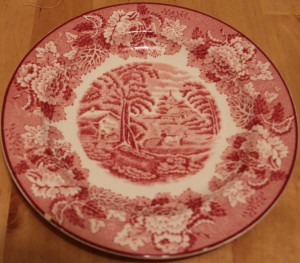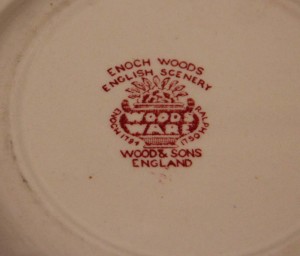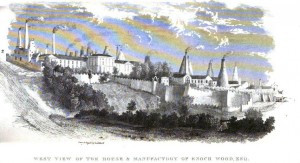What a Find!
December 29th, 2010
After lunch this afternoon, my dashing darling took me for an amble up 23rd Street, stopping in at some of the classiest thrift stores I’ve ever seen. In one of the more modest establishments, my eye was drawn to a shelf of assorted china and glassware, perhaps seeking reassurance after the painted tea set that caught my fancy at City Opera Thrift turned out to bear a price tag of $650.
Like most women with a yen for history, I have a soft-spot for transferware. There were a few stacks of modern collectible blue and white transferware plates on the shelf, but the only one that was even vaguely interesting was priced at $12.99 — a testament to the continued popularity of this style. (It was the height of fashion in the 18th century, but declined to the status of “everyday” by the middle of the 19th, before achieving the status of collectible around the time of the American bi-centennial.)
Then I noticed a few small red and white transferware plates off to the side. The first two were pretty ordinary, with a roundness to their form that belied anything earlier than 1970. They were simply marked Japan on the reverse. But hiding at the bottom of the stack, I was delighted to find this:
Now I’m no expert on transferware, but I do have a passing acquaintance with the patterns of Enoch Wood & Sons (leading manufacturers of British earthenware during the first half of the 19th century) and some of the motifs on this plate seemed very familiar. I nearly crowed when I turned it over and found this:
According to an online list of Enoch Wood marks, this one dates to just before World War I, having first been seen in 1917. It’s similar to one that was used during the 1960s, but this does seem to be the original 1917 version. The scene in the center of the plate is charming and clearly printed, though hardly as detailed as the 19th century examples I’m familiar with. But I love it — I’d like to move into the little house at the left, and grow cucumbers in the garden frame next to the farmer with the horses. Then I’d throw a tea party for the minister who lives in the manse at the upper right and serve cucumber sandwiches on my Enoch Wood plates.
Here’s what a gentleman named John Ward had to say about Enoch Wood in his 1843 report on The borough of Stoke-upon-Trent:
“The firm of Enoch Wood And Sons take the lead as Earthenware manufacturers, and have occupied that position for many years; the head of this house, Enoch Wood, Esq., whose name we have had occasion to introduce on several previous occasions, commenced business, in 1783, on his own account, and, in 1790, was joined by James Caldwell, Esq., late of Linley-Wood; the business being from that time conducted under the firm of “Enoch Wood and Caldwell,” until the year 1818, when Mr. Wood purchased Mr. Caldwell’s property in the concern, and the present firm of Enoch Wood and Sons had its commencement. They now occupy the sites of four ancient pot-works, near together, on the two sides of the old Pack-horse-Lane, (formerly a public thoroughfare from Burslem to Newcastle, but now stopped up,) and which are connected by means of a subterraneous passage, as well as by the arched gallery shewn in the first of the two plates introduced hereafter, which exhibits the east front of the large manufactory in FounTain-place,* erected by Mr. Wood, in 1789. A windmill was, in the first place, employed here in raising water and preparing the clay, ready for the hands of the potters, and for grinding glaze and colours, but this work is now done by steam-power.”
Mr. Ward goes on to identify Enoch Wood as the patriarch of the current generation of English earthenware manufacturers, the heir apparent — at least in terms of fame and reputation — of Josiah Wedgwood (died 1795). There is a great deal of Enoch Wood earthenware in the United States, as much of his work was intended exclusively for the lucrative and insatiable (though reportedly less discerning) American export market, including some patterns of American country life as well as his more prolific English country scenes.
Again, evidence from John Ward:
“The establishment of Enoch Wood and Sons has been hitherto employed in the manufacture of earthenware of every variety, and they have of late years been reckoned the largest exporters of that article from Staffordshire to the United States of America. They have recently combined the making of Porcelain with their other business.”
Enoch Wood was also known for innovations, introducing various mechanical advantages, including steam power, to his great factories, seen here in illustration from John Ward’s treatise.
I’ve saved the best part of this story for the last. While I’m sure my little early 20th century plate (probably a dessert plate, or part of a tea service) isn’t terribly valuable, I’m pleased to say that I snagged it for the grand total of 99 cents!





No one is close to being as understated as my wife when she is being understated. So I will say it in boldface: NINETY NINE CENTS!WHAT AN INCREDIBLE FIND! NINETY NINE CENTS!!!!